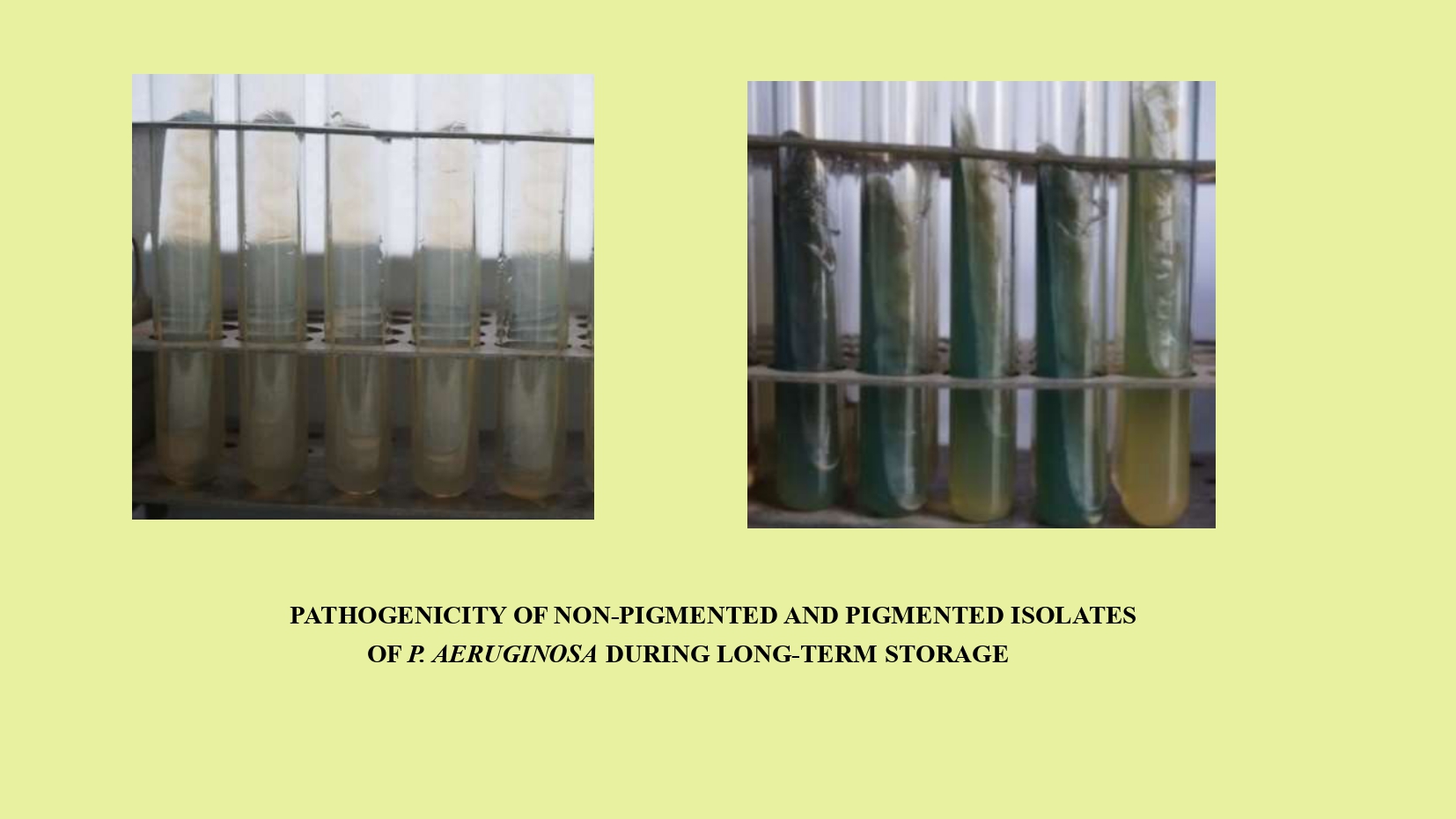Pathogenicity of non-pigmented and pigmented isolates of P. aeruginosa during long-term storage
DOI:
https://doi.org/10.15587/2519-8025.2023.295545Keywords:
P. aeruginosa, poultry pseudomonosis, pathogenicity, LD50, broiler chickens, culture storage, strains, isolatesAbstract
The aim: to study the pathogenicity of non-pigmented P. aeruginosa isolates compared to those that synthesize pigment during long-term storage for broiler chickens.
Materials and methods. Bacteriological studies were carried out in accordance with generally accepted methods. Initially, P. aeruginosa and other bacterial microflora were isolated from poultry farms, pathological material from poultry. The type of microorganisms was identified using Bergey's identifier. The obtained isolates were examined by morphological characteristics (according to Gram), tincture, cultural, biochemical, pathogenic properties and sensitivity of selected cultures to antibiotics were studied. After the expiration of 3 years, the main biological properties of the isolates were monitored. To establish pathogenic properties, a bioassay was performed on white mice and one-week-old broiler chickens of the Cobb 500 cross (intraperitoneally by washout from daily agar culture at a dose of 0.2 cm3, which corresponds to the previously established LD50).
The results. With parenteral infection by washout from agar daily culture of pigmentless isolates at a dose of LD50, chickens died within the first - second day, in this case 87.50 % of the cultures showed pathogenicity. Experimental parenteral infection with washings from a daily culture of pigmented isolates of P. aeruginosa at a dose of LD50 led to the death of one-week-old chickens within 24-48 hours, in this case 75.00 % of the isolates showed pathogenicity.
Clinical and pathological signs of infection with pigmented and non-pigmented P. aeruginosa isolates were similar.
Conclusions. A comparative analysis of cases of pathogenicity of non-pigmented and pigmented isolates of P. aeruginosa on one-week-old broiler chickens of the Cobb-500 cross was carried out. In the experiment, we found that among the non-pigmented isolates, compared to the pigmented pathogenic isolates, 12.5 % more were detected in chickens. This emphasizes the importance of differential diagnosis for pseudomonosis, because infection with non-pigmented strains often goes undiagnosed
References
- Algammal, A. M., Eidaroos, N. H., Alfifi, K. J., Alatawy, M., Al-Harbi, A. I., Alanazi, Y. F. et al. (2023). oprL Gene Sequencing, Resistance Patterns, Virulence Genes, Quorum Sensing and Antibiotic Resistance Genes of XDR Pseudomonas aeruginosa Isolated from Broiler Chickens. Infection and Drug Resistance, 16, 853–867. doi: https://doi.org/10.2147/idr.s401473
- Walker, S. E., Sander, J. E., Cline, J. L., Helton, J. S. (2002). Characterization of Pseudomonas aeruginosa Isolates Associated with Mortality in Broiler Chicks. Avian Diseases, 46 (4), 1045–1050. doi: https://doi.org/10.1637/0005-2086(2002)046[1045:copaia]2.0.co;2
- Walker, S. E., Sander, J. E., Cheng, I.-H., Wooley, R. E. (2002). The In Vitro Efficacy of a Quaternary Ammonia Disinfectant and/or Ethylenediaminetetraacetic Acid-Tris Against Commercial Broiler Hatchery Isolates of Pseudomonas aeruginosa. Avian Diseases, 46 (4), 826–830. doi: https://doi.org/10.1637/0005-2086(2002)046[0826:tiveoa]2.0.co;2
- Fiçici, S. E., Durmaz, G., Ilhan, S., Akgün, Y., Köşgeroğlu, N. (2002). Bactericidal effects of commonly used antiseptics/disinfectants on nosocomial bacterial pathogens and the relationship between antibacterial and biocide resistance. Mikrobiyoloji bulteni, 36 (3-4), 259–269.
- Fotina, T. I., Stepanishchenko, M. M., Fotina, H. A. (2004). Analiz izoliatsii umovno-patohennoi mikroflory v ptakhivnychykh hospodarstvakh Ukrainy. Veterynarna medytsyna, 84, 864–870.
- Fotina, T. I. (2001). Umovno-patohenni mikroorhanizmy ta infektsii ptytsi, yaki vony vyklykaiut. Sumy, 104.
- Nazarchuk O. A. (2016). Аntiseptics: modern strategy of struggle with causing agents of the іnfection complications. Klinichna khirurhiia, 9, 59–61.
- Majtán, V., Majtánová, L. (2002). Antibacterial efficacy of disinfectants against some gramnegative bacteria. Central European journal of public health, 10 (3), 104–106.
- Rueda, J., Amigot Lázaro, J. A., Ducha, J. (2003). Evaluating the effect of quaternary ammonium disinfectants on bacterial strains of animal origin. Revue scientifique et technique, 22 (3), 1097–1104. doi: https://doi.org/10.20506/rst.22.3.1459
- Walker, S. E., Sander, J. E. (2004). Effect of BioSentry 904 and Ethylenediaminetetraacetic Acid-Tris Disinfecting During Incubation of Chicken Eggs on Microbial Levels and Productivity of Poultry. Avian Diseases, 48 (2), 238–243. doi: https://doi.org/10.1637/7049

Downloads
Published
How to Cite
Issue
Section
License
Copyright (c) 2024 Yevheniia Vashchyk, Olga Bobrytska, Sergiy Shtrygol', Andriy Zakhariev, Ruslan Dubin, Olga Shapovalova

This work is licensed under a Creative Commons Attribution 4.0 International License.
Our journal abides by the Creative Commons CC BY copyright rights and permissions for open access journals.
Authors, who are published in this journal, agree to the following conditions:
1. The authors reserve the right to authorship of the work and pass the first publication right of this work to the journal under the terms of a Creative Commons CC BY, which allows others to freely distribute the published research with the obligatory reference to the authors of the original work and the first publication of the work in this journal.
2. The authors have the right to conclude separate supplement agreements that relate to non-exclusive work distribution in the form in which it has been published by the journal (for example, to upload the work to the online storage of the journal or publish it as part of a monograph), provided that the reference to the first publication of the work in this journal is included.








